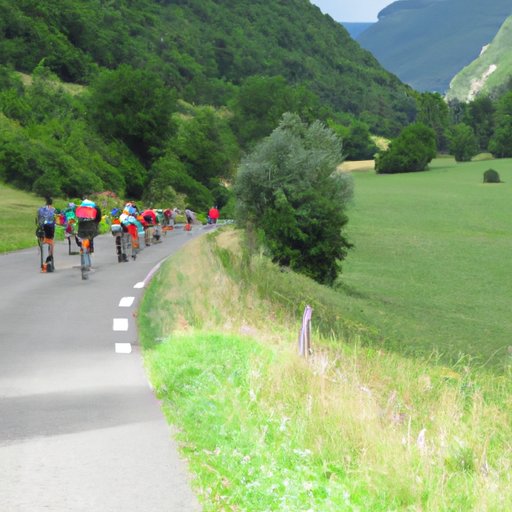I. Introduction
The Tour de France is an annual multi-stage bicycle race that takes place across France, with occasional dips into neighboring countries, and is one of the most prestigious races in the cycling calendar. It was first held in 1903 and has since become a global phenomenon, attracting millions of fans from all over the world. This article aims to explore the history, significance, and future of the race, as well as provide training tips, insights into competitors’ experiences, and an examination of the race’s diverse routes and landmarks.
II. The History and Evolution of Le Tour de France: From its Humble Beginnings to a Global Phenomenon
Le Tour de France has come a long way since its inception over a century ago. The race was founded by the French newspaper L’Auto, as a way to boost circulation and rival its competitors. The first Tour de France consisted of just six stages, making up a total of 2,428km. Following its inaugural success the following years saw it increase both in length and popularity. Today, the event is comprised of 21 stages, over a length of 3,500km.
The race faced many challenges in its early days, including accusations of doping, the first of which occurred back in 1904 when a rider was suspected of having taken strychnine. These accusations damaged the reputation of the race but ultimately led to its evolution into the controlled and heavily regulated sport it is today.
III. The Top 10 Most Memorable Moments in Tour de France History
The Tour de France has seen many unforgettable moments since its formation. From champions who have crushed their competition to sensational crashes, these moments have contributed to the mystique of the race. Some of the most notable moments include Lance Armstrong’s seven consecutive wins (1999-2005), Eddy Merckx’s record breaking 34 stage wins, and the first stage victory by a British rider.
IV. How to Train for the Tour de France: Tips from the Pros
Training for the Tour de France is no walk in the park. It requires months of rigorous preparation, including endurance training, hill climbing, and nutrition plans that match energy output. Other essential factors include core strength exercises, recovery periods, and mental preparation. The suggestions made by professionals include training rides of around 30 hours per week, focusing on specific pedal strokes, and taking time to stretch. Above all, the key is to monitor, listen to and adapt to your body.
V. The Tour de France’s Most Scenic Routes: Exploring France’s Breathtaking Landscapes on Two Wheels
The race’s itinerary traverses France, with occasional further trips to countries such as Spain, Belgium, and Switzerland. It follows landscapes that are breathtaking and historic, with stopovers in picturesque French towns and villages. Some of the most scenic parts of the route include the winding streets of the Loire Valley, the imposing mountain ranges of the Pyrenees, and the tranquil beaches on the coast. For spectators, the sights along the race paths provide the backdrop for unforgettable moments and create lifelong memories.
VI. The Future of the Tour de France: Innovations and Changes on the Horizon
The Tour de France may have been around for over a century, yet the organizers are always on the lookout for new and innovative ideas that will enhance its appeal. This includes new artificial intelligence (AI) technologies that help predict riders resting departments and suggest how to allocate energy and nutrition intake optimally. The organizers also aim to make the race more accessible by enabling more significant fan participation and interaction via social media.
VII. Chasing the Yellow Jersey: Inside the World of Tour de France Competitors
The life of a Tour de France competitor is a unique blend of training, travel, and the thrill of the race. Riders are fiercely dedicated to their craft, knowing that only a small number are equipped to be awarded the celebrated yellow jersey. Competitors experience physically challenging hill climbs, flat out sprints, and endurance tests of over 3,000 km over a three week-long period. Interviews with competitors provide insights into rigorous training schedules, strict dietary routines, and mental preparation needed to be in top form for such a demanding race.
VIII. Conclusion
The Tour de France is an iconic sporting extravaganza that has been embedded in the fabric of French culture for over a century. From its humble beginnings, it has evolved significantly, and is now a global phenomenon celebrated by millions of fans all over the world. As this article has demonstrated, the Tour de France is much more than a mere bike race as it involves rigorous training, an exploration of majestic landscapes, and showcases some of the most exceptional cycling talent in the world.
(Note: Is this article not meeting your expectations? Do you have knowledge or insights to share? Unlock new opportunities and expand your reach by joining our authors team. Click Registration to join us and share your expertise with our readers.)
